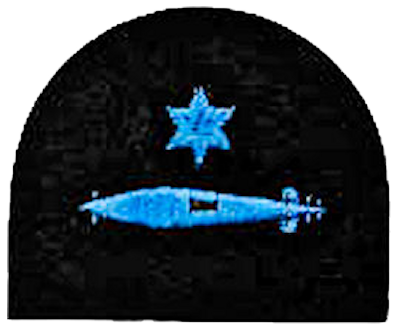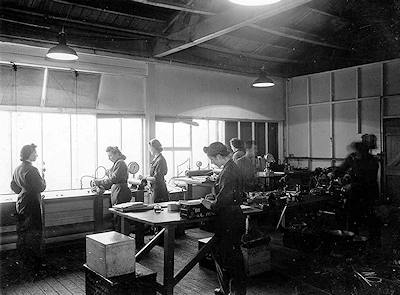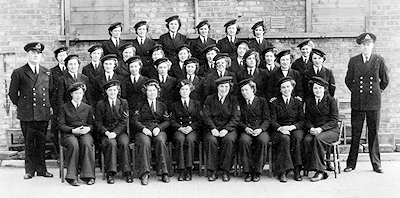


Barbara Sugden 1943
 Branch badge of WRNS Torpedoman (worn on upper right arm)
Branch badge of WRNS Torpedoman (worn on upper right arm)
 Some of the wrens on Course 57 at HMS VERNON (R)
{click image to enlarge}
Some of the wrens on Course 57 at HMS VERNON (R)
{click image to enlarge}
 Depth charge pistol workshop, HMS CAROLINE
Depth charge pistol workshop, HMS CAROLINE
 Torpedo Electrical workshop, HMS CAROLINE
Torpedo Electrical workshop, HMS CAROLINE
 Torpedo Machine Shop, HMS CAROLINE
Torpedo Machine Shop, HMS CAROLINE
 Torpedo Section personnel, HMS CAROLINE
Torpedo Section personnel, HMS CAROLINE
 The 32 WRNS (T) ratings of the Torpedo Section personnel, HMS CAROLINE
The 32 WRNS (T) ratings of the Torpedo Section personnel, HMS CAROLINE
The wartime reminiscences of WRNS (Torpedoman) Kathleen Anderson
The wartime reminiscences of Leading WRNS (Torpedoman) Margaret ‘Peggy’ Smith
Basic training
My time in the WRNS began in September 1943 soon after my 18th birthday, when I arrived at Mill Hill initial training centre in London (H.M.S. PEMBROKE III) with suitcase, travelling rug and torch. The latter two for use in the air raid shelter as London was being bombed at the time. Those days are a blur of lectures, square bashing and floor scrubbing. One day we were taken into a gas filled hut and told to remove our masks and come out quickly. I moved very fast!
The day came when our categories were allocated and I was to be a torpedo mechanic. To this day I will never know why as my School Certificate results were all in arts subjects. We were taken to a clothing store and kitted out in uniform, plus bellbottoms, sailor's cotton flannels and seamen's jerseys as we would be working on the ships, and were also given some long-legged woollen knickers known as 'Pick' garments to wear under bellbottoms in cold weather. They were often the butt of ribald jokes from the matelots. Wrens were the only women's services allowed to wear their own underwear and therefore we were given some clothing coupons, most of which went on black silk stockings for off duty.
Our group were then posted to Barkston Gardens in Earls Court and travelled every day to an electrical training centre in Hounslow. There we were taught the basics of electrical circuits and had to wire them up on large boards. These boards were so hard we hit our fingers more often than the cleats. The local chemist did a roaring trade in Elastoplasts. One enduring memory of our time there was the day the cooks overslept and gave us cold cabbage on toast for breakfast!
Training to be a Torpedoman
The course completed we moved on to HMS VERNON in Brighton and were billeted in a hotel just behind the Royal Crescent hotel. There was an air raid shelter in front of the building where we spent many nights as this was the time of the doodlebugs. The beach was covered in barbed wire against invasion and there were Ack Ack posts on the promenade and nights could be very noisy. Torpedo training was done at Roedean School which was taken over by the Navy and commissioned as HMS VERNON (R). It was a lovely building high up on the cliffs with a beautiful chapel where we sometimes went to Sunday services.
Our lectures were held on the second floor of a house next to Royal Crescent on the sea front, as Wrens were trained separately from the male ratings. We were taught by a long serving Petty officer showing us how to use equipment such as an electrical tester called a 'megger', he used to say "now you eeave around the aandle", needless to say that became his nickname. I covered myself in glory one day when we were in the basement and told to find a fault on a circuit and remove it. I found the fault but turned off the junction box at the wrong side of the circuit and found myself pinned on the opposite wall. It took some time to live that down.
Although we worked hard, we also played hard and enjoyed dancing in the Dome or the Cinema Ballroom. As there were both American and French-Canadian troops stationed nearby, we all soon learnt to do the jitterbug. We were also invited to dances at HMS KING ALFRED an officers training station nearby. The course over we were distributed around the various quarters to fill in time until our posting came through. We were given red sailors torpedo badges and had to embroider over them in blue thread as no blue ones were available for wrens. Another girl and I were sent to help in the galley in a nearby wren's quarters. My abiding memory of that place was of peeling buckets of sprouts and washing down the larder shelves and I didn't care too much for the cockroaches we sometimes encountered.
Drafted to Northern Ireland
Shortly after Christmas we were on the move again, this time to HMS CAROLINE in Belfast. We went by transport to London and then made an overnight journey by train to Stranraer where we caught the ferry to Larne. I shall never forget my first sight of Ireland as the dawn was breaking after a long journey on the ferry dodging mines and possible U Boat attack. After a final train journey to Belfast we went on to report to the Regulating office where our quarters were allocated to us. These were in 43 Somerton Road which was also the WRNS mess quarters. Later, all the torpedo wrens were moved to no 61 but continued to walk down the road to the mess for meals.
The next morning transport took us down to Pollock Dock and we were dropped in pitch darkness outside the police post to be signed in. There we were met by three burly Irish policemen with guns strapped to them, from there we moved on to the depth charge workshops where we were to work for the next ten months. The chief petty officer in charge explained how the depth charge pistol plates were to be rubbed down with very fine emery paper then checked in a pressure tube for signs of leaks. It was absolutely essential that they were perfect when men's lives were at stake and our chief was a perfectionist. He was a long serving seaman and commanded great respect as he was always very fair. The job itself was very boring but we had the radio, usually with Worker's Playtime and there was lots of chatter.
Finally, we were moved down stairs into the main workshops and allocated to various parties, some were on searchlights, another on Hedgehog Anti-Submarine mortars and I went to the gyro compass party to work with Chief Jago and Lofty Bridle, a long serving leading hand. They were great to work with and always looked after me. I had a cold once and Lofty brought me a tot of rum for several days. I did not ask how he managed it! My main job was to go round the ship to the various repeaters and send the readings back down the speaking tubes. I had some adventures on the ships. On one occasion going down a hatch in the stern and returning after doing the reading I climbed the ladder only to find the hatch cover loose and found myself flat on the deck below with a sailor looking down at me and saying "Oh , my god it’s a wren" and coming to rescue me. Another time I was working on a ship where the ablution block was open to the gangway. Foolishly I turned round when there were shouts to attract my attention to be faced by several naked matelots killing themselves with laughter. I soon learned to keep my nose in the air when passing that way again.
Maintaining Captain Class frigates
Our base ship was HMS CAROLINE, an older ship converted into a headquarters and training ship for the Ulster Division of the RNVR before the war. The officers were based there and one of them took us for squad drill. I don't think he cared much for wrens as he certainly put us through our paces. One member of our group had been a Fleet Street journalist and she did a cartoon of him with a whip and wrens crawling away dripping with blood. Someone put it up in the officer's mess. He tried very hard but never found out who did it..
Pollock dock was the base for the Captain Class frigates, some were diesel, powered others sent over from USA under a lease lend agreement had steam turbines. They were used as escort vessels to protect the convoys from U Boat attacks; they were also used on Mediterranean or Russian convoys. The Russian route was one of the worst because of the intense cold. One of the sailors on HMS BYRON told me that they were advised to make their way to the wardroom and drink what they could when in Russian waters, if torpedoed as the icy waters would kill in minutes. I can't vouch for the veracity of that story. Most of us had boy friends in each escort group, so it was quite a juggling job when two groups came in at the same time! There were HM Ships BYRON, BALFOUR, GORE, GARLIES GOULD, KEMPTORNE and many others most of which the gyro party had worked on.
Normally when a ship came into the dock it was usual for tugs to guide it round in the basin at the top of the dock. One day an American destroyer came in and when offered the use of tugs he refused saying he could manage his own ship and so he turned in the basin at high speed sinking two patrol boats and another small boat; I was not around at the time but heard later that the air was blue when Captain D. ordered him out of the dock and told him in no uncertain tones never to return.
Working at sea
There were times when a ship was due to join a convoy and had gyro trouble when out in the bay and it was necessary for us to go out by ferry to work on board. One memorable occasion I shall never forget. Transport took us down to Bangor and we had to wait a while for a boat to take us out to the ship as the sea was very rough. Finally, we boarded a small trawler and set off. The sea was so rough that the skipper tied me in the wheelhouse to stop me being blown overboard. My heart sank when arriving alongside the ship and one minute we were level with the keel and next minute the deck. Lofty said "when we are level with the deck, I want you to jump but be very sure before you do otherwise its curtains for you". My heart sank until I looked up and saw a dozen pairs of willing hands waiting to catch me, so I jumped. We were on board until the sea settled and all went well except that I was very seasick.
Life in Belfast
Alongside the workshops was a Mission to Seamen canteen which we visited regularly for tea and a snack, usually cheese on toast. The ladies manning it were all volunteers and one of them was a Mrs Flynn, the mother of the film star Errol Flynn. We were warned, however, never to ask about him. The tables were covered with black and white check lino and we played Shove Halfpenny on them. Upstairs was a chapel and I remember one sad service we attended there after a ship had been torpedoed, the watertight doors closed and she was towed home with the members of the crew who were killed still on board. That day really brought home the horrors of war to me.
We sometimes used naval transport to work but mostly we used the trams which ran up the Antrim Road. This was quite an event if we were leaving at pack-up time for the dock workers. The trams left from near the dockyard and there was no queuing just every man for himself and often it would be so full there were people hanging on a ledge behind. It was not unusual to see the conductor running behind to the next stop. We very soon learned to push like the rest.
As naval time was always 5 minutes before time, we had to be in at night by 10.25 pm for 10.30pm. If anyone was going to be later it was usual to sign them in and leave the front window off the catch. Unfortunately, I chose this method of arriving when we had a visiting officer for the night. Climbing through the window I felt a hand on my shoulder and a loud voice said "Do you usually come in this way." Needless to say I was gated for the rest of the week. One of the Officers started a naval choir and we were once asked by the BBC to take part in a Sunday night hymn singing from a chapel in Bangor.
Towards the end of the war in Europe a number of Belgians were sent to Cherry Valley to recover from their experiences with the Resistance and the officers invited some of us to a dance. It was a great evening and they gave us some of the most gorgeous Belgian pastries I have ever tasted. We went to several more dances there and always danced the last waltz to the tune of J'attendrai.
The end of the war in Europe
We did not hear that the war in Europe was over until late in the day and after a rushed supper went down into the city to join in the celebrations nobody worrying about the time we returned. Soon afterwards a German submarine U 1023 surrendered and was brought into Pollock Dock. Lofty, Stella and I went on board to do a check. It was amazing how small it was inside, in fact I found it very claustrophobic and was glad to go ashore. We learnt later it had been taken to Londonderry possibly to be scuttled.
Soon after this the base began to wind down, the ships were being prepared to return to USA and Torpedo wrens were no longer needed. Lofty and Chiefy were posted to Liverpool, Lofty later being sent to the Far East as the war was still on there. There was a rumour that we were to be sent to Portsmouth to retrain as cooks and stewards. I think it was only a rumour. However, my friend Stella and I were put in the torpedo stores to help wind things up there. One strange signal came round saying that if anyone came in for spares, they were to take the whole box not just one individual item. I never understood the logic of that order but it caused us a lot of hassle with the sailors who insisted on taking one item. I usually won that argument!
Finally, the store was to be closed and we had to deal with all the paperwork. There were quite a lot of odd papers left over that we did not know what to do with and I am ashamed to say that with the aid of a sailor working alongside us we burnt them in the coke stove.
Just before Christmas our demob papers came through and we returned to civvy life. It was good to be going home but sad to leave behind what had been a memorable experience and making lifelong friends. There was a great feeling of companionship amongst the girls; in fact, the few of us who are left are still in contact today. It is an experience I will never forget.
BARBARA (SUGDEN) HOPKINS
5th February 2011
© 1999-2024 The Royal Navy Research Archive All Rights Reserved Terms of use Powered byW3.CSS
At the end of June 1945, the Admiralty implemented a new system of classification for carrier air wings, adopting the American practice one carrier would embark a single Carrier Air Group (CAG) which would encompass all the ships squadrons.
Sturtivant, R & Balance, T. (1994) 'Squadrons of the Fleet Air Arm’ list 899 squadron as conducting DLT on the Escort Carrier ARBITER on August 15th. It is possible that the usual three-day evolution was cancelled due to the announcement of the Japanese surrender on this date and was postponed for a month.
Gordon served with the radio section of Mobile Repair UNit No.1 (MR 1) at Nowra, he was a member of the local RN dance band, and possibly the last member of MONAB I to leave Nowra after it paid off. .
In March 1946 I joined 812 squadron, aboard HMS Vengeance, spending some time ditching American aircraft north of Australia. Eventually we sailed for Ceylon ( Sri Lanka ) landing at Trincomalee and setting up a radio section at Katakarunda. In the belief that we were exhausted we were sent to a rest camp at Kandy for a few weeks. We moved down to Colombo to pick up Vengeance and returned to Portsmouth via the Suez Canal . I was discharged in November 1946.
Comments (0)